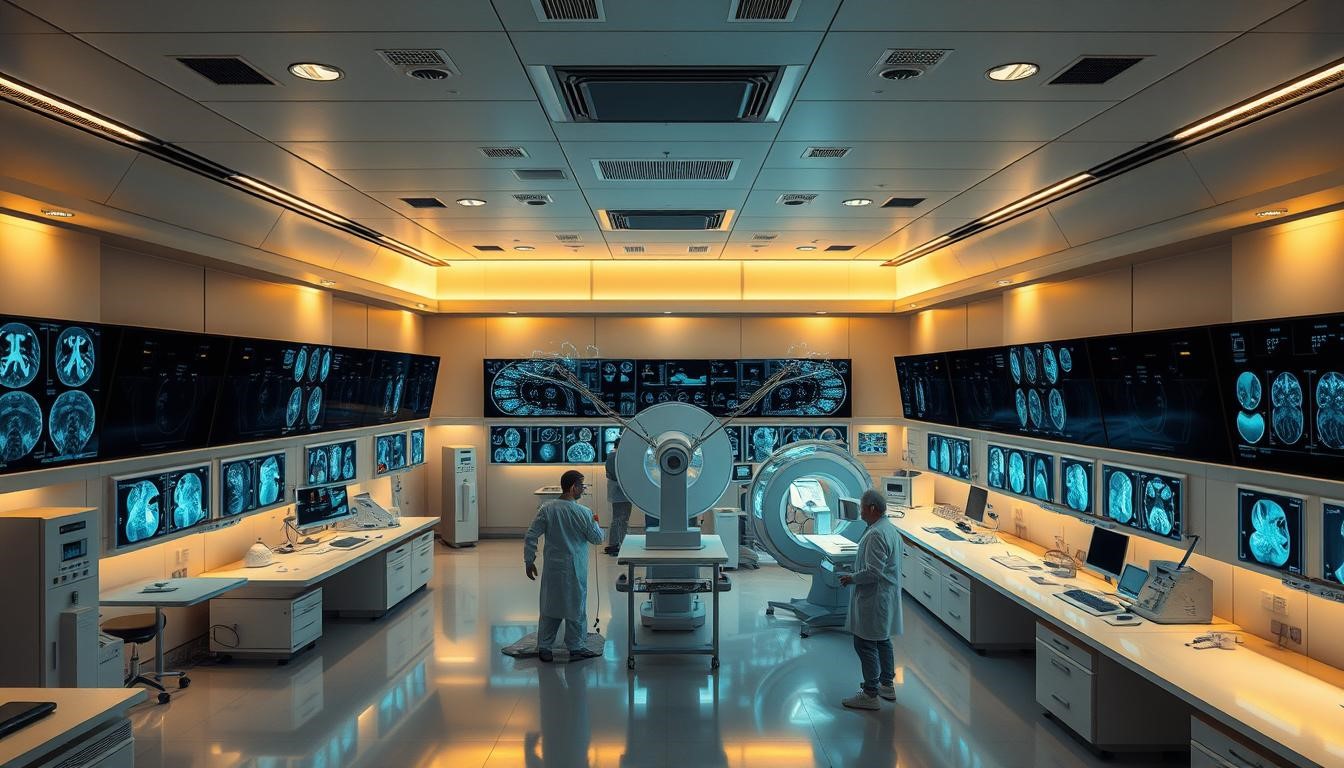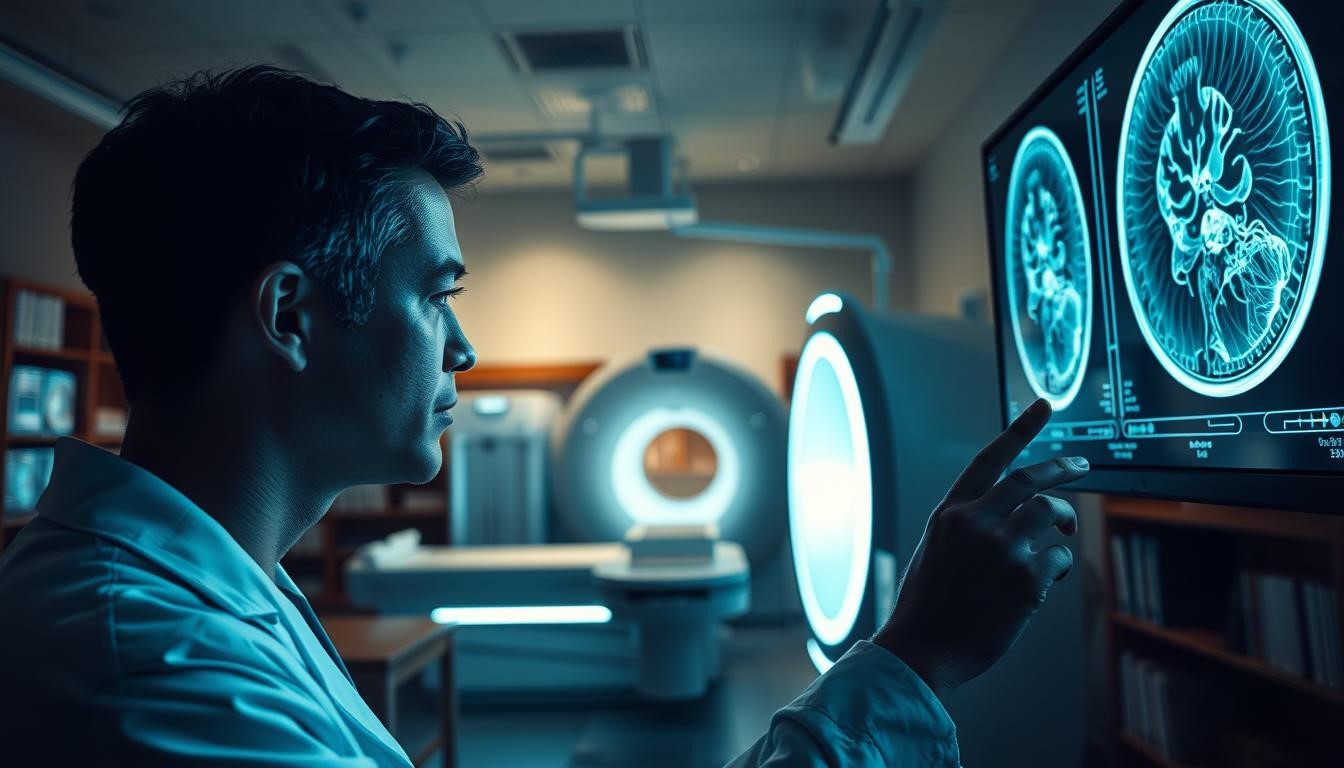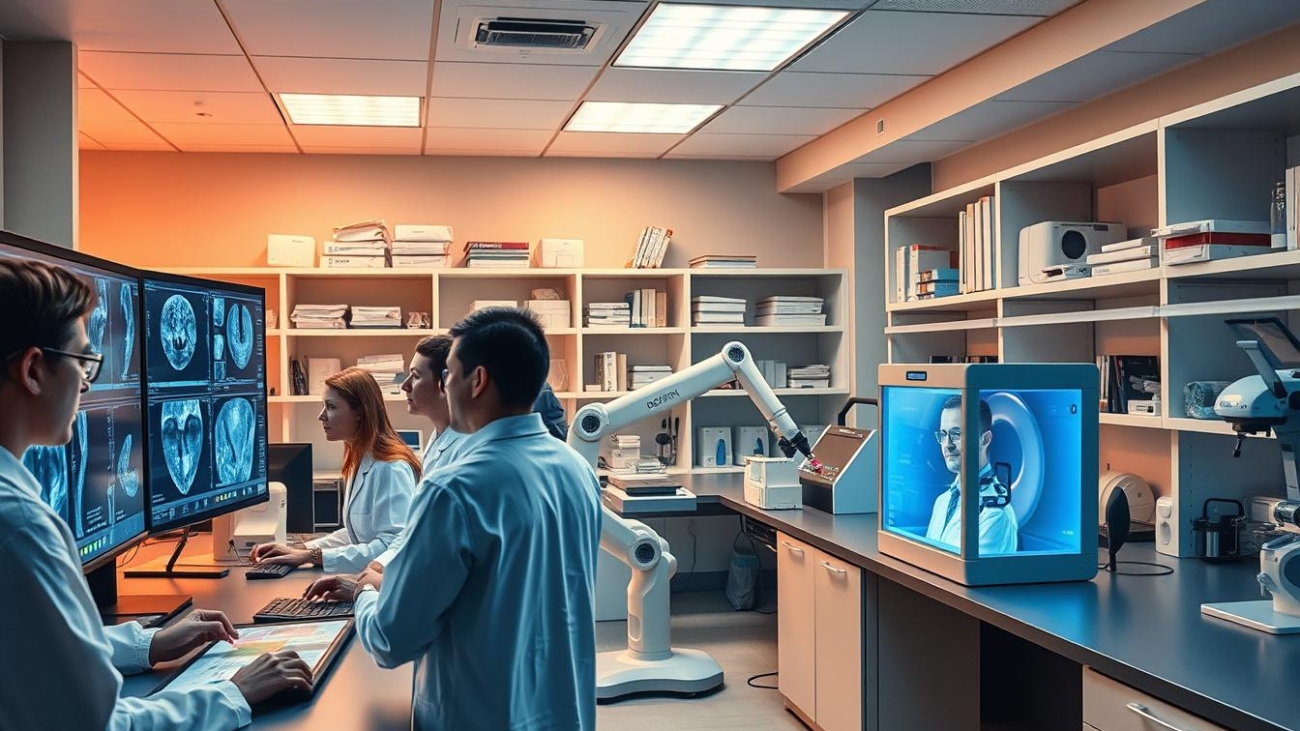The shortage of radiologists is a big problem. It affects how well healthcare works and the care patients get. With more need for imaging tests, the lack of radiologists is getting worse.
AI-powered solutions are being looked at to solve this issue. By adding AI to radiology, we can make things run smoother. This also makes tests more accurate and helps radiologists do less work.
This change could really improve how radiology works. It could make patient care better and make things run more smoothly. With so few radiologists, using AI in radiology is a big help.

The Growing Radiologist Shortage Crisis in Canada
The shortage of radiologists is a big problem that needs quick action. This issue is not the same everywhere in the country. It changes a lot from one area to another.
Current Statistics and Trends in Canadian Healthcare
Recent numbers show a big shortage of radiologists. This affects how well healthcare works. The country’s healthcare system is struggling to keep up with the needed staff.
It looks like more people need radiologists than there are. This means current staff have to work harder and feel more stressed.
Regional Disparities Across Provinces
There are big differences in how many radiologists each province has. Some places have much fewer than others. For example, rural areas often can’t get to radiology services as easily as cities can.
Impact on Patient Wait Times and Diagnostic Accuracy
The lack of radiologists makes patients wait longer for tests and treatments. This delay can affect how quickly they get help. Also, the extra work can make it harder for radiologists to be accurate.
This shows we really need new ways to solve the shortage of radiologists. We must find ways to improve care for patients.
Understanding AI in Radiology: Core Technologies
AI is changing radiology with machine learning, deep learning, computer vision, and natural language processing. These technologies are making it easier to analyze and understand medical images.

Machine Learning and Deep Learning Applications
Machine learning and deep learning are key for analyzing images in radiology. They help create models that learn from big datasets, spot patterns, and predict outcomes. Deep learning, a part of machine learning, uses neural networks to handle complex data like medical images.
Computer Vision in Medical Imaging Analysis
Computer vision is essential for medical image analysis. It lets computers understand and interpret visual data from images. This tech is used to find abnormalities, segment images, and classify diseases.
Natural Language Processing for Radiology Reports
Natural Language Processing (NLP) is used to read and understand radiology reports. It extracts important information and offers insights for diagnosis and treatment planning. NLP helps automate report generation and boosts the accuracy of radiology reports.
How AI-Powered Solutions Address Workforce Challenges
AI is changing radiology by solving big workforce problems. It automates simple tasks and boosts how well doctors can diagnose. This helps reduce the stress on radiologists.
Workflow Optimization and Efficiency Gains
AI makes radiology departments work better. Automated image analysis and preprocessing are key to this improvement.
Automated Image Analysis and Preprocessing
AI quickly goes through lots of images, finding important details. It flags these for doctors to check right away. This makes diagnosis faster and more accurate.
Triage and Prioritization Capabilities
AI can sort and prioritize radiology cases. It looks at how urgent and complex they are. This means critical cases get attention quickly, helping patients and cutting wait times.
- AI can analyze imaging data to identify critical findings.
- Prioritization based on AI analysis helps in managing workload.
- Enhanced patient care through timely intervention.
Reducing Radiologist Burnout and Improving Job Satisfaction
AI takes over routine tasks, cutting down on radiologist burnout. This lets radiologists work on harder cases, making their job more rewarding.
AI is making a big difference in radiology. It’s making workflows better, improving how accurate diagnoses are, and making radiologists happier at work.
Key AI Radiology Applications in Canadian Clinical Practice
AI is changing radiology in world in many ways. It makes diagnoses more accurate, makes work flow better, and helps patients get better care.
Diagnostic Support Systems for Common Conditions
Diagnostic support systems are becoming more common. They use machine learning algorithms to look at medical images. This gives radiologists important information to help them diagnose.
Chest X-ray and CT Scan Analysis
AI is key in analyzing chest X-rays and CT scans. It can spot things like pneumonia or lung nodules early. This means doctors can act fast.
Automated Screening Tools for Early Detection
Automated screening tools are also important. They help find diseases like breast cancer early. This is through analyzing mammograms.
- Improved detection rates
- Reduced false positives
- Enhanced patient care
Quality Assurance and Error Reduction Mechanisms
AI is also vital for quality and reducing mistakes in radiology. It looks at imaging data to find errors or problems. This makes diagnoses more accurate.
Quality assurance mechanisms include checks for image quality and following protocols. Error reduction involves AI finding issues that might be missed by humans.
Implementation Challenges and Considerations
AI is changing radiology, but there are hurdles to overcome for it to work well in Canadian healthcare.
Health Canada Regulatory and Approval Pathways
Getting AI radiology solutions approved by Health Canada is key. You need to know the regulatory approval process. This means showing that your AI is safe and works well.
Following Health Canada’s rules is vital to get your product on the market.
- Understanding the classification of AI software as a medical device
- Preparing for pre-market submission requirements
- Ensuring post-market surveillance and vigilance

Integration with Existing Provincial Healthcare Systems
AI solutions need to fit into current healthcare systems well. This means healthcare integration that makes things work smoothly. It’s important for provinces and AI developers to work together.
- Developing standardized data exchange protocols
- Training healthcare professionals on AI system usage
- Monitoring and evaluating AI system performance
Data Privacy and Security Under Canadian Regulations
Data privacy and security are top priorities for AI in radiology. Canadian laws, like PIPEDA, protect patient data. AI providers must keep this data safe.
Overcoming these challenges is essential for AI to improve patient care in Canada. It must meet all the rules.
Canadian Success Stories: AI in Radiology Transforming Healthcare
AI is changing radiology in Canada. Hospitals and startups are leading the way. They are making healthcare better with AI.
Hospital Implementation Case Studies
In Toronto, a hospital used AI to help doctors. It made diagnosis faster and more accurate. They saw a 30% drop in wait times and a 25% cut in mistakes.
Measurable Outcomes and Benefits
AI in radiology has brought big wins. It has made patient care and hospital work better. A study showed AI helped radiology teams work more efficiently.
Canadian AI Radiology Startups and Research Innovations
Canada has a growing number of AI radiology startups. They are pushing the limits of radiology. These startups are creating new tools and checks, helping healthcare everywhere. Working together, startups and hospitals are making healthcare better for everyone.
Conclusion
AI is changing radiology healthcare system. It can help solve the shortage of radiologists. AI makes work more efficient, improves accuracy, and lowers stress.
The future of radiology in world is bright. AI technologies are key to this progress. They use advanced algorithms to help doctors give better care.
As AI becomes more common in healthcare, patient care will get better. Canada is on track to lead in AI healthcare. This is thanks to AI’s role in radiology.
FAQ
What is the current state of the radiologist shortage in Canada?
Canada is facing a growing shortage of radiologists. This shortage varies by province. It affects how quickly patients get diagnosed and how accurate those diagnoses are.
How can AI-powered solutions address the radiologist shortage?
AI can help by making radiology work more efficient. It automates routine tasks and sorts cases. This way, urgent cases get attention right away.
What are the core technologies used in AI for radiology?
AI for radiology relies on machine learning and deep learning. It also uses computer vision and natural language processing. These technologies help analyze images and interpret reports.
How are AI radiology applications being used in Canadian clinical practice?
In Canada, AI is helping diagnose common conditions. It’s used to analyze chest X-rays and CT scans. It also helps with early detection tools, improving patient care.
What are the challenges in implementing AI solutions in radiology?
Implementing AI in radiology faces several hurdles. These include navigating Health Canada’s rules and integrating with healthcare systems. Ensuring data privacy and security is also a challenge.
Are there any success stories of AI in radiology in Canada?
Yes, there are many success stories. Hospitals have seen real benefits from AI. Canadian startups are also leading in AI radiology research.
How does AI improve diagnostic accuracy in radiology?
AI enhances diagnostic accuracy by analyzing images and spotting abnormalities. It reduces human mistakes. It also supports doctors in diagnosing common conditions.
What is the future of radiology in an AI-enhanced Canadian healthcare system?
The future of radiology looks bright with AI. AI will keep getting better, changing healthcare. It will make radiology better and improve patient care.


Add a Comment